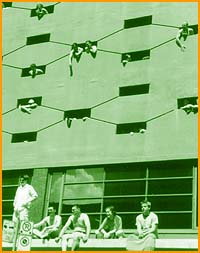One of the biggest challenges faced by Pride parade fans is finding a good spot to watch it.
The farther from the village the better. The centre of the ghetto is crazy – Church and Bloor right over to Bloor and Yonge are a mess.
“South of College tends to be way less busy, and that’s not that far even for queers to walk,” says parade co-chair Joel Rotstein. “It’s not right by the village obviously, but that is where I always watch it because it’s not so crowded.”
“North of College is like 10 to 20 people deep and unless you’re bringing your own ladder or milk crate it’s really hard to see.”
Knowing someone who lives on the route helps. “Bring them a bottle of wine and stay there,” suggests Rotstein. “And we’re not encouraging people to sit on their roofs.”
Last year someone fell out off a second storey window, causing a gap in the parade as medics swooped in.
Bus shelters are also a prime location for viewing. According to
Mediacom, which owns and operates most of the bus shelters in the Greater Toronto Area, sitting on them is no problem. “It’s not an issue – we’ve never had complaints or concerns about it. People are just sitting around, they’re not damaging stuff and everybody is all over the place anyway – that is part of the parade,” says Mediacom’s director of marketing, Kim Warburton.
It is commonly thought that the beginning and the end of the parade is pretty empty – untrue, says parade co-chair Anita Parker-Laite. “I had that impression but previous organizers said that that’s sometimes not true. And a friend of mine told me that Dundas and Yonge are zoos. And I think there is a lot more room between College running down through the Gerrard area.”
(The parade begins at Bloor and Church, over to Yonge and down to Dundas, then along Dundas for few hundred feet.)
Parker-Laite also recommends the nooks and crannies left on the boulevard where College splits. “In between the trees and stuff there’s room and it’s a slower area.”
For the first time, Pride is considering bleachers for 300 along the route, but would have to charge for seats to make up the rental costs. But Pride is given a city permit to close the streets – and one stipulation is that they don’t charge admission.
Some pointers: Wellesley to St Joseph is traditionally the peak of the parade so it can be a zoo; scout Yonge ahead of time and see what bars, stores and coffee shops have windows on more than one floor or businesses on the second floor (Payless Shoes, O’Reilly’s Pub, the Living Well, Glad Day Bookshop and Carrington’s). Some of the big Yonge St burger joints and restaurants have big windows and are a few steps up from ground level.
Get to the parade early, mush yourself up against the barricades and don’t move; the west side of Yonge is the shaded side; ledges and concrete overhangs are prime locations but you risk breaking your neck and possibly someone else is below you; a lot of people tend to hang out in the front to catch goodies being thrown from floats (while quantities last).
And you could always watch the parade from home: City TV and Showcase will air it.

 Why you can trust Xtra
Why you can trust Xtra


